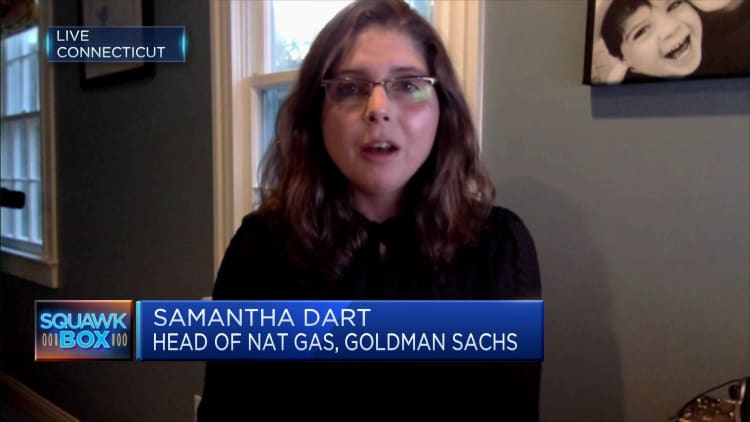SINGAPORE — Shares in Asia-Pacific mostly tumbled on Tuesday after the S&P 500 fell overnight and closed in bear market territory, but mainland Chinese stocks bucked the overall regional trend to recover from earlier losses.
The Shanghai Composite closed 1.02% higher at 3,288.91 while the Shenzhen Component climbed 0.204% to about 12,023.79.
In Hong Kong, the Hang Seng index swung between positive and negative territory, sitting 0.15% lower in its final hour of trading. Hong Kong-listed shares of Alibaba continued to sit close about 2.7% lower.
Most of the other major markets in the region were in negative territory.
The Nikkei 225 in Japan fell 1.32% on the day to 26,629.86, while the Topix index shed 1.19% to 1,878.45.
Risk assets have plummeted with recession risk rising given the surge in yields and expectations of the Fed doing a Volcker.Tapas StricklandDirector of Economics, National Australia Bank
South Korea's Kospi slipped 0.46% to close at 2,492.97.
Australia was one of the worst performers in the region. The S&P/ASX 200 returned to trade Tuesday following a holiday yesterday, and closed 3.55% lower at 6,686. MSCI's broadest index of Asia-Pacific shares outside Japan fell around 0.6%.
Cryptocurrencies also saw another day of sell-off on Tuesday, and bitcoin fell below $21,000 at one point. The world's largest cryptocurrency recovered slightly from earlier losses and was last trading at $21,817 at 3.56 a.m. ET Tuesday.
U.S. Treasury yields also retreated from earlier gains. The yield on the benchmark 10-year Treasury note recently saw its biggest move since March 2020, and last stood at 3.299%. The 2-year rate also recently saw a big jump and is currently trading at 3.284%. Yields move opposite to prices.
The 2-year rate had earlier sat higher than the 10-year Treasury yield, representing an inversion – a measure closely watched by traders and often viewed as a potential indicator of recession.
On Wall Street overnight, the S&P 500 fell nearly 4% overnight to 3,749.63, closing in bear market territory, or down more than 20% from its January peak.
Other major indexes stateside also saw big declines. The Dow Jones Industrial Average dropped 876.05 points, or 2.79%, to 30,516.74. The tech-heavy Nasdaq Composite lagged, plunging 4.68% to around 10,809.23.
Fed expectations
The losses on Wall Street came as investors braced for a potentially faster pace of interest rate hikes by the U.S. Federal Reserve following Friday's hotter-than-expected consumer inflation report.
Fed policymakers are now contemplating the idea of a 75-basis-point rate increase later this week, according to CNBC's Steve Liesman. That's bigger than the 50-basis-point hike many traders had come to expect. The Wall Street Journal reported the story first.
"I think the simple way of explaining it is that, if [the Fed] don't get inflation under control now, they may have a 10-year inflation problem and we go back to you know, the economic circumstances of the 70s," Eric Robertsen, global head of research at Standard Chartered Bank, told CNBC's "Squawk Box Asia."
The stock markets are now starting to "reconcile" with that prospect, Robertsen said.
"Risk assets have plummeted with recession risk rising given the surge in yields and expectations of the Fed doing a Volcker," Tapas Strickland, director of economics at National Australia Bank, said in a note on Tuesday.

In the early 1980s, former Fed Chief Paul Volcker helped tame inflation by raising benchmark interest rate to close to 20% and sent the economy into recession.
"If the Fed hikes by 75bps that will be a true Volcker moment and underscore front loading, a 50bp hike in contrast would cement the likelihood of 50bp hikes at every meeting for the rest of the year," Strickland said.
Currencies and oil
The U.S. dollar index, which tracks the greenback against a basket of its peers, was at 104.97 — off an earlier high of 105.263.
The Japanese yen traded at 134.57 per dollar, stronger as compared with levels above 135 seen against the greenback yesterday. The Australian dollar was at $0.6954 after yesterday's fall from above $0.70.

Oil prices were higher in the afternoon of Asia trading hours, with international benchmark Brent crude futures up 0.79% to $123.23 per barrel. U.S. crude futures climbed 0.71% to $121.79 per barrel.
"We have a situation where not only oil balances are incredibly tight, but also refining capacity globally is very tight," said Samantha Dart from Goldman Sachs.
"The problem is our outlook suggests that we still need to see additional increases in oil prices so that we can have a reduction in demand to balance to market," said Dart, who is senior commodities strategist and head of natural gas research at the firm.
"We're in a situation where there is no supply elasticity. So you're left with demand to resolve the problem."
— CNBC's Abigail Ng contributed to this report.


